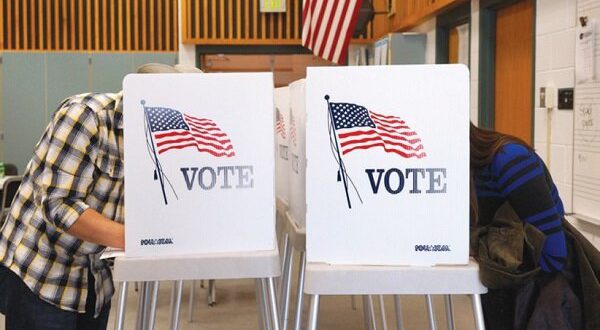by Dr Abolfazl Fateh- The upcoming presidential elections in the United States will be held on November 5, 2024. Although eight months remain until these elections, speculation about their possible outcome has already begun due to their international implications. Similar to previous US elections, this series of notes will gradually outline the prospects of these elections for esteemed audiences.
Candidates
The process of introducing candidates from the two main parties of America entered its final stages on Thursday (March 13). Donald Trump has surpassed his intra-party rivals and also secured the green light from the Supreme Court. Joe Biden, as the current President, will also traditionally and uncontestedly be the Democratic Party’s nominee. However, discussions regarding his physical health persist and will continue. Some media outlets have even reported the possibility of his sudden withdrawal and replacement by other well-known figures like “Michelle Obama” at the Democrats’ final convention in the summer. Nevertheless, until Biden himself decides, it is unlikely that another person can be introduced as his competitor.
Internal and External Components Influencing the Elections
The elections will be influenced by numerous internal and external components, both in terms of discourse, strategy, and performance. However, it seems that in domestic politics, key themes and disparities between the candidates of the two parties will revolve around economic components, immigrants, especially unprecedented immigration from the Mexican border, the rights of African Americans, women’s rights (abortion), and gender minorities, renewable energies, approaches to “artificial intelligence,” health and insurance, and ultimately educational facilities (student loans).
In foreign policy, as expected, the Russia-Ukraine war, regional tensions (Israel-Palestine), especially the fate of Gaza and the military withdrawal or permanence in the region, approaches and policies towards the growing power of China, NATO and global trade, how America confronts the fundamental question of “superpower challenge or decline,” and most importantly, “America’s role in the future world” and perhaps to some extent issues such as “Iran” or “Taiwan” and “Afghanistan” and “Iraq” and “Yemen,” “Saudi Arabia,” and the type of relationship America has with “totalitarian” governments around the world will be the main focus of electoral criticisms and will allocate the point of display of candidates’ power and policies in relation to each one.
Status of “Joe Biden”
So far, Biden has not fulfilled many voters’ expectations, although he has achieved considerable successes in the economic field and controlling inflation to some extent. Summarizing 95% of the polls – including the latest Gallup poll – from last month (February 2024), it indicates that satisfaction with Biden’s performance has reached its lowest level during his presidency, showing a number below 38%. This poll evaluated Biden’s performance in foreign policy areas especially (Ukraine, Israel-Palestine conflict) and economic performance and approach to immigration.
At the beginning of his presidency (January 2021), Biden enjoyed about 57% satisfaction. In August of the same year, it dropped to 44%, a number that never exceeded later. He descended to the lowest figure of 37% in April, October, and November 2023, and now it stands at 38%. Biden’s personality has been seriously criticized by his critics for lack of leadership and decision-making power, lack of transparency and outspokenness, lack of charismatic qualities, and doubts about his physical and mental abilities. Although his supporters portray him as more reliable, more universally spoken in terms of discourse, and possessing long governance experience and a predictable personality in domestic and foreign arenas.
Status of “Donald Trump”:
Donald Trump, especially since 2023, has faced numerous legal disputes and challenges. He has been summoned to multiple courts and has faced heavy tax penalties. However, efforts to disqualify him from the elections did not succeed, and he managed to achieve significant legal victories to participate in the 2024 elections. Legal challenges have not had a significant impact on his position, and he has generally challenged the formal legal and political structures domestically and internationally and accused them of corruption. Among his other abilities, he has been characterized by polarizing the atmosphere, breaking cultural norms, and adopting very strict positions, which many consider extremist, regarding immigrants.
In terms of popularity, it can be said that he has followed a path opposite to Joe Biden’s. According to the average of all polls, while his popularity dropped to about 38% in January 2021, it gradually reached 40% in August 2021 and 42% in June 2022, and recently reached 43% in February 2024. However, recent polls do not indicate an extraordinary surge or radical decline in Trump’s popularity in recent months. He appears to be in better physical and mental condition compared to Biden, resulting in fewer criticisms of him in this regard. However, Trump’s critics consider his leadership style to be divisive, lacking ethical principles and commitment to social norms, and costly in domestic and especially foreign policy, and they condemn his performance during the pandemic. Although his supporters prefer him for his economic and racial policies (white supremacy), military power enhancement, and prioritization of American interests.
Evaluation and Analysis of the Complexities of the Next Elections
The trend of weak satisfaction with Biden’s performance and Trump’s popularity, along with questions about Biden’s physical and mental condition, has led many to predict Trump’s high likelihood of victory. However, perhaps this conclusion is premature. A look at the trend charts shows that the upcoming US presidential elections are characterized by unique complexities.
Based on available data, although Trump’s popularity trend shows an increasing trend, it has never exceeded about 44% from January 2021 to March 2024, and it resembles the chart of previous US presidential elections. Mr. Trump has relatively stable “positive votes” or hardcore supporters, and “negative votes” or relatively stable and meaningful opponents. While Trump and his rhetoric have succeeded in maintaining traditional and partisan supporters, they have not yet achieved much success in attracting new supporters, especially among academics, youth, and “Generation Z,” as well as immigrants from Latin America and Spanish-speaking America, and there is no polling indicating a new wave of support for Trump and his popularity exceeding 50% at the societal level.
In contrast, Mr. Biden has shown a wide range of ups and downs. He has had the ability to attract the majority of American people at times, and now he is at the lowest level of popularity. On the other hand, Trump has never had the majority of American people’s votes. Even when he became president based on electoral votes, especially the votes of swing states, in the same elections, Mrs. Clinton had about 5 million more votes nationally. In fact, it can be said that since 2016, in American society, in presidential elections, the Democratic Party discourse has had, to some extent, more supporters than the Republican Party. But the personality and performance of the presidential candidate and the ability or weakness of the Democratic campaign in defending this discourse have changed the electoral outcome.
Current Status and Role of Progressive Movements:
The current situation in American society is very similar in some aspects to 2016 and in others to 2020, and it can still be said that the outcome will depend more on the performance of the Democratic candidates rather than the Republican candidate (Trump). In 2016, Hillary Clinton lost more to her own mistakes than to Trump.
As polls show, the Democratic candidate is currently in a weak position and needs to make significant strides in a short period to make up for it. However, whoever the Democratic candidate is, whether Biden or another, will have one positive aspect: many influential voters support progressive movements and are unwilling to vote for Trump due to his right-wing or extremist rhetoric and racial supremacist discourse. Progressive movements in America, such as the women’s movement, the Black movement, immigrant movements, and left-wing movements, are looking for a reason and excuse to stand behind Democratic candidates. For them, it is enough for the Democratic candidate to show some initiative or tangible hope. For them, a personal victory like Trump’s would be a setback or even a defeat in terms of discourse. This situation also applies to Muslims and even some Jews. Despite all the dissatisfaction with Biden’s policies towards Palestine and the Gaza war, standing behind Trump is much more difficult for them than standing behind Biden, and if they don’t find any positive signs among the Democrats, many of them may prefer to stay home and remain silent.
The Situation of “Uncertainty”
If polls and charts are any indication, it can be said that the outcome of the upcoming US elections is by no means predetermined for the two-party candidates now, and these elections will see numerous events and ups and downs until the last days, and the current performance of the US president in the coming months and still the influential debates in deciding the final votes of the “swing states” will have a significant impact. The quantity and quality of advertising campaigns, the use of social media, the role of artificial intelligence, interventions by influential domestic figures such as Barack Obama, and any foreign interventions in an election that is highly competitive are of paramount importance and should be further discussed in the future. Also, the role of scandals and revelations in these elections should not be overlooked. However, the effects of these potential scandals are greater on Democrats. Since Trump came to power and disrupted social, political, and personal value systems, the most severe scandals have had little impact on the Republican voters’ choice, and it seems that these potential scandals and revelations will largely encourage or discourage Democratic supporters.
Based on this, Republicans and Trump will not necessarily have an easier job than the 2020 elections because Trump’s supporters alone will not be enough for his victory. Trump’s victory will depend on the weakness of Biden and the possibility of mass absenteeism among non-partisan voters. High participation in the elections and maximum participation of progressive movements will not only be detrimental to him but will also make his defeat certain. However, if the Democratic candidate (likely Biden) continues his current weaknesses, he will not be in a position to easily repeat the Democrats’ victory. If he fails to take advantage of the opportunity for recovery in the next eight months, or significant international events turn against him, or the current inflation, which is controlled under current conditions and to some extent considered Biden’s strength, gets out of control and becomes an increasing trend, or if the candidate cannot encourage progressive movements to maximize their presence in the elections, then a significant portion of non-partisan votes will not come into play, and in that case, like 2016, in more swing states, the elections will be relinquished, and the Democratic candidate will lose due to himself and his performance. Otherwise, contrary to many predictions, Trump’s chances of winning will be lower, and Democrats will once again win the elections.
The 2022 Elections
While the nature and scope of presidential elections differ from midterm congressional and senate elections, their outcomes can shed some light on the trends. In the 2022 congressional and senate elections, Republicans showed some progress compared to the 2020 elections, but previous trends among college-educated individuals, youth, Black Americans, immigrants, and women persisted. According to published statistics, college-educated voters still favored Democratic candidates by 56%, while Republicans garnered 43%. Among voters without a college degree, this trend was almost reversed, with 57% supporting Republicans and 42% supporting Democrats. Among women, 51% supported Democratic candidates, while 48% supported Republicans. However, Republicans had a higher level of support among men, at 54%. Among Spanish-speaking and Latino voters, Democrats received 60% of the vote, compared to 39% for Republicans. Finally, in the 2022 elections, contrary to some predictions of heavy losses for Democrats, Congress ended up almost evenly split between Republicans (222 seats) and Democrats (213 seats), while the Senate, which has a structure closer to the presidency, ended with a Democratic victory (51 seats to 49).
Conclusion
Based on the data from the 2022 elections, it is evident that the gap between Republicans and Democrats has somewhat narrowed. Additionally, from the trends of satisfaction or dissatisfaction with Biden, the popularity or unpopularity of Trump, and the ideological divides, as well as gender, age, and racial compositions of supporters of each candidate, it can be concluded that the intensity of competition has increased since 2020. However, the final victory of either candidate in the upcoming presidential election still does not show certainty or even a clear advantage, and undoubtedly, both candidates will face significant challenges in their campaigns. Therefore, the ultimate outcome of these elections can swing in either direction.
Note: These analyses are based on A: reviewing past trends, B: evaluating data published in the media and polling institutions, and C: the experiences of the author’s notes on previous elections in the US, Turkey, Iraq, and Iran. These analyses are presented as a perspective on the trends and probabilities of future US elections. If time permits, any changes and different possibilities regarding these elections will be discussed in future notes in the coming year, God willing.
Abolfazl Fateh
23 Esfand 1402 (March 13, 2024
 صراط عشق صراط عشق
صراط عشق صراط عشق




